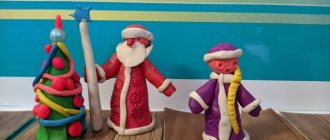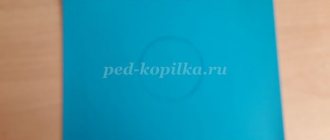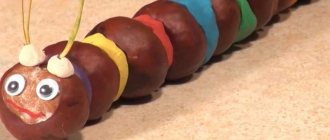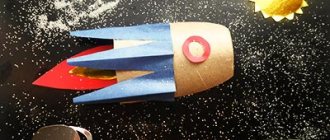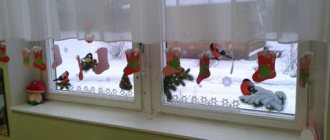OD summary for application in the middle group “Rocket”
Lesson summary on application in the middle group “Rocket”
Target:
teach children to cut out shapes and glue them onto a sheet of paper.
Objectives:
- teach children to hold scissors correctly;
-develop a sense of composition in children: teach how to harmoniously place details on a sheet of paper, create a beautiful composition; - stick parts onto the surface of the sheet; - develop creativity and fine motor skills in children; - evoke positive emotions in children; - expand your horizons. Methodological techniques:
introductory conversation, demonstration of visual material, teacher’s story, physical exercises, finger gymnastics.
Materials:
black cardboard, silver rectangle, blue square, scissors, PVA glue, glue brushes, rags; visual pictures depicting space, a portrait of Yu. A. Gagarin, video “Rocket Launch”
Progress of the lesson
Flashback: Guys, April 12 is Cosmonautics Day. Do you know why our country celebrates this day? (No) - Because on April 12, 1961, a man flew into space for the first time. It was Yuri Alekseevich Gagarin, our compatriot. (the teacher shows a portrait of Gagarin) - During the launch, a flame broke out in the rocket engines, the rocket took off and disappeared into the blue sky. (video “Start of the ship”) Yuri Alekseevich was the first to see the entire Earth from space. (the teacher shows an illustration of the planet Earth from space) Play: Guess the riddle: She spread her scarlet tail and flew away into a flock of stars. Our people built this Space... (Rocket) So you and I are now going to build a rocket, but first, let's warm up.
Fizminutka
Everything is ready for the flight, (raise your hands forward, then up.) All the guys are waiting for rockets. (connect your fingers above your head, imitating a rocket.) There is little time for takeoff, (march in place.) The astronauts stood in a row. (stand up with a jump - legs apart, hands on the waist.) Bow to the right, (to the left, bend to the sides.) Let's bow to the ground. (bends forward.) The rocket flew. (jumping on two legs) Our cosmodrome is empty. (squat down, then rise.)
Now let's make some rocket appliqués. The black background is space. We will make rockets from geometric shapes. We take a silver rectangle - this is the body of a rocket without a nose - and paste it onto the background - the “night sky” is inclined at an angle as if the rocket is flying into space. Then we take the square and cut it diagonally into two triangles, leave one triangle unchanged - this is the nose of the rocket - and glue it above the body rectangle; We cut the second triangle in half into two small triangles - these are the wings of the rocket - and glue them to the sides of the body (bottom). Before we get started, let's stretch our fingers.
Finger gymnastics
In the starry sky, the stars are shining (we show the stars, fingers intertwined) An astronaut flies in a rocket (we depict the flight of a rocket: join hands at the top) The day flies, the night flies (we bend our fingers) And looks down at the ground (we depict a porthole)
Educator: Now let’s go to the tables. Let's get to work. (Children choose materials and create their own “Rockets” applications. The teacher helps.)
- Guys, look how wonderful the work turned out. How many different missiles do we have? Today, like real astronauts, we visited space. Did you like it? Children's answers.
“Rocket” – GCD for paper construction
Smirnova Irina Grigorievna Tregubova Larisa Viktorovna Grebenikova Tatyana Alekseevna educators MBDOU "Kindergarten of the village of Tomarovka of the Yakovlevsky urban district"
The material was sent for publication in the All-Russian printed collection of practice-oriented materials “Preschool and primary education - modern methods and technologies of teaching and upbringing” - July-August 2021.
ROCKET NOD in the senior group - paper construction
Goal: to expand children's understanding of space. To develop the ability to create a three-dimensional design of paper rockets using a diagram and a sample.
Advertising message
Tasks:
- Educational: consolidate the names of geometric shapes: circle, rectangle, triangle; construction parts: cone, cylinder, cube. Teach children how to twist a rectangle into a cylinder, a circle into a cone.
- Developmental: develop design skills, the ability to convey the expressiveness of a composition, using the features of paper as a design material. Develop spatial thinking, imagination, and the ability to make inferences. Form a critical attitude towards your actions, objectively evaluate your work and the work of your comrades.
- Educational: to cultivate interest in paper construction. To cultivate accuracy in working with glue and scissors, independence, and initiative. Cultivate a desire to help a friend.
Integration of educational areas : Speech development, cognitive development, artistic and aesthetic development.
Enrichment and activation of the dictionary: Space, cosmodrome, planets, astronaut, orbit, body, nozzles, porthole, design bureau.
Methods and techniques: game problem situation, riddle, conversation - dialogue, looking at illustrations, outdoor play, verbal play, productive activity of children, self-analysis of work, summing up - reflection.
Equipment: a letter asking for help, illustrations depicting rockets, a sample of a finished rocket, parts of a three-dimensional construction set, an audio recording of space music.
Handouts: rocket design diagrams, cardboard, colored paper, scissors, glue, napkins, oilcloth.
Progress of continuous educational activities:
Cheerful music plays and children join the group.
Educator: Guys, today we have guests, let's say hello and invite them to come.
Children: hello!
Educator:
We will all stand in a circle together, You are my friend and I am your friend, Let’s hold hands tightly and smile at each other.
The teacher makes a riddle about space.
Educator: Guys, it’s not in vain that we started talking about space! Today our group received a letter asking for help. Shall we read it? (Yes!)
Educator: Dear guys! Soon there will be an epidemic on the planet “Zhelezyaka”! All the rockets and aircraft here have broken down, and the robots cannot make their flights. Help!
Guys, let's help the robots from the planet "Zhelezyaka"? How can we help robots?
Children's answers: Make rockets and launch them into space onto the planet.
Educator: Can you?
Children: Yes!
Educator: Who creates rockets? (designers, engineers)
Educator: today I suggest you be designers and design rockets for the inhabitants of the planet “Zhelezyaka”. I, as the chief designer, propose to consider rockets (there are illustrations of rockets on the easel)
Next, children examine a sample of a finished rocket made of colored paper and cardboard.
Educator: What parts is the rocket made of?
Children's answers: The nose of the rocket is made of a cone, the main part - the body - is made of a cylinder, the nozzles are made of triangles, the windows are made of circles.
Educator: but before you start creating rockets, do you want to play? (Yes!)
Outdoor game “Lay out the details of the construction set”
Children are divided into two teams and come up with a cosmic name for their team. Countdown: 3, 2, 1 – Start!
After the game, the teacher says that creating a rocket is a difficult and responsible job. You can pair up, agree on who will do what, and help each other.
Educator: please go to the design bureau!
Repetition of the rules for working with scissors and glue.
- Scissors must not be left open.
- You should not bring scissors close to your face.
- Pass the scissors to each other with the rings first, not the tip.
- Handle the glue carefully.
Look how many dangerous objects are lying around! If you do not follow safety precautions, you can injure yourself or a neighbor!
Educator: Guys, we have a problem! As you already said, to design a rocket you need a cone and a cylinder, we don’t have them.
But there is a design scheme. She will help us.
Look at it carefully and tell me, from what geometric figure can you get a large cylinder?
Children's answers: from a large rectangle, twisting it into a cylinder - a rocket body; from the circle, twisting it - the nose part. We attach the airlocks - triangles, and the portholes - circles to the body.
Educator: It's time to get to work (on the tables there is a set of geometric shapes for each child - a large rectangle, a circle, two triangles, small circles for portholes). During the activity, the teacher provides individual assistance.
Children place finished rockets in one line at the Mechta cosmodrome
Presentation of finished works
Educator: What beautiful rockets you have made, but can all rockets fly to the planet “Zhelezyaka”?
I'll give you one gold star. This is your voice. You will give it away - vote for your favorite work - (put a star next to the rocket).
Which rocket gets the most stars will be considered the best. (This is how children perform visual analysis of work)
Educator: Well done designers! Everyone did it! Will the inhabitants of the planet “Zhelezyaka” like your rockets? (Yes!). Applause!
Educator: Guys, I’m wondering
- -What are people called who fly into space on spaceships? (astronauts)
- -What was the name of the world's first astronaut? (Yuri Gagarin)
- -What was the name of the ship that lifted him into the sky? ("East")
Guys, do any of you want to become an astronaut?
To become an astronaut, what qualities do you need to have? (to be strong, courageous, resilient, responsible)
Educator: You are right, but astronauts must also follow the rules.
Word game "Space rules"
- If you want to become an astronaut, you must know a lot, a lot...!
- Any space route is open to those who love... work.
- Only friendly starships can take with them…on a flight.
- We will not take the boring, gloomy and angry into… orbits.
- Our main rule is to carry out any... order
- Fast rockets are waiting for us to fly to... planets.
- Whichever one we want, that’s the one… we’ll fly.
Let's train like astronauts and fly. I think that now the robots from the planet “Zhelezyaka” will invite us to visit.
Reflection: Guys, what did we do today? Who did they help? What games did you play? Was it difficult for you? What was the most difficult thing? What did you like most? Children's answers.
Literature:
- Kutsakova L.V. Construction and manual labor in kindergarten: Program and lesson notes M: TC Sfera, 2021. – 341 p.
You can see the table of authors and learn more about the collections HERE
Paper application for Cosmonautics Day
A bright space-themed applique is presented in this lesson. It is made of paper. It depicts rockets that cross the infinite space of the Universe. You can do a similar craft with your children for Cosmonautics Day in kindergarten.
Offer to make it for preschool children or primary schoolchildren. The work is also suitable for collective creativity. Not only paper was used here, but also other material options, for example, foamiran, foil, cotton wool. By preparing and collecting many details, you will get the same bright specimen.
To complete the application, you must prepare:
- a set of colored paper and cardboard;
- cotton wool;
- handle;
- golden or silver foamiran;
- gold or silver foil;
- scissors;
- glue.
How to make a space applique from paper step by step
Step 1. Take paper and cardboard for work. Prepare a background of any color, for example blue. All parts must be placed on a rectangular sheet.
Step 2. Cut out the first part - the large rocket body. Use red or other paper. First draw a sketch with a pencil, then cut out along the contour.
Step 3. Start assembling, focusing on the dimensions of the parts. Glue the rocket body in the center at an angle.
Step 4. Add blue round portholes to the elongated hull.
Step 5. Glue cotton wool at the bottom to simulate puffs of smoke escaping from the nozzle.
Step 6. Additionally, cut out the blanks for the housings of the units from foil and paper of a different bright color.
Step 7. Glue the prepared parts in other places of the application. Complete the rockets with portholes.
Step 8. Glue an escaping flame to each figure from below. Cut out feather-like pieces from yellow and orange paper.
Step 9. The final stage is design. You need to simulate outer space using different bright elements. Firstly, you can cut out not only traditional stars, but also round ones; not only paper, but also silver foamiran is also suitable. Prepare figures of comets and meteorites, cut out a circle and stick it on as a planet. Draw craters and an orbit on it.
An interesting space-themed application using paper is ready. Any first grader, and even a child of the senior preparatory group in kindergarten, can handle it.
The craft is complicated by a large number of details, so I want to look at it carefully.



